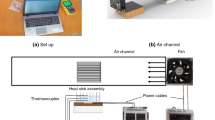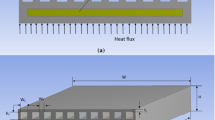Abstract
In this study, a numerical model is developed to study the behaviour of conventional heat sink and phase change material (PCM) heat sink for electronics cooling applications. Two different PCMs, RT35HC (ΔTm = 34–36 °C and ΔH = 240 kJ/kg) and RT44HC (ΔTm = 41–44 °C and ΔH = 250 kJ/kg), are selected for the analysis. A comparison has been made between conventional heat sink and PCM-based heat sink under constant and variable heat flux conditions. Further, four different hybrid heat sink design configurations are studied during the cooling period (solidification) and compared with PCM-based heat sink. During the heating period, the conventional heat sink is subjected to different convective cooling environments (h = 10–50 W/m2-K). The results showed that the PCM heat sink achieved base temperature equivalent to the conventional heat sink with the heat transfer coefficient between 30 and 40 W/m2-K under the constant heat flux condition. Under the variable heat flux condition, the base temperature of the PCM heat sink is very much less than the conventional heat sink subjected to 50 W/m2-K. During the cooling period, hybrid heat sinks reduced the heat transfer coefficient by ten times less than that of the PCM heat sink.
Graphic abstract












Similar content being viewed by others
Abbreviations
- \(A\) :
-
Mushy zone constant (kg/m3-s)
- \(C_{\text{p}}\) :
-
Specific heat (J/kg-K)
- \(f_{\text{l}}\) :
-
Liquid volume fraction/average melt fraction
- \(\overrightarrow {{F_{\text{b}} }}\) :
-
Body force term (N/m3)
- g :
-
Acceleration due to gravity (m/s2)
- h :
-
Heat transfer coefficient (W/m2-K)
- \(\Delta H\) :
-
Latent heat of fusion (kJ/kg)
- k :
-
Thermal conductivity (W/m-K)
- \(p\) :
-
Pressure (Pa)
- \(\overrightarrow {S}\) :
-
Darcy’s momentum source term (N/m3)
- t :
-
Time (s)
- \(T\) :
-
Temperature (K)
- \(\overrightarrow {V}\) :
-
Velocity vector in x and y directions
- \(x,y\) :
-
Coordinate axes
- \(\beta\) :
-
Coefficient of thermal expansion (1/K)
- \(\rho\) :
-
Density (kg/m3)
- λ :
-
Constant
- \(\mu\) :
-
Dynamic viscosity (Pa s)
- eff:
-
Effective
- l:
-
Liquidus
- m:
-
Melting
- mush:
-
Mushy zone
- s:
-
Solidus
- HHS:
-
Hybrid heat sink
- PCM:
-
Phase change material
- SPT:
-
Set point temperature
- VHF:
-
Variable heat flux
References
Al Siyabi I, Khanna S, Mallick T, Sundaram S (2018) Multiple phase change material (PCM) configuration for PCM-based heat sinks-an experimental study. Energies 11:1629. https://doi.org/10.3390/en11071629
Ali HM, Ashraf MJ, Giovannelli A, Irfan M, Bin Irshad T, Hamid HM, Hassan F, Arshad A (2018) Thermal management of electronics: an experimental analysis of triangular, rectangular and circular pin-fin heat sinks for various PCMs. Int J Heat Mass Transf 123:272–284. https://doi.org/10.1016/j.ijheatmasstransfer.2018.02.044
Arshad A, Ali HM, Ali M, Manzoor S (2017) Thermal performance of phase change material (PCM) based pin-finned heat sinks for electronics devices: effect of pin thickness and PCM volume fraction. Appl Therm Eng 112:143–155. https://doi.org/10.1016/j.applthermaleng.2016.10.090
Baby R, Balaji C (2013) Experimental investigations on thermal performance enhancement and effect of orientation on porous matrix filled PCM based heat sink. Int Commun Heat Mass Transf 46:27–30. https://doi.org/10.1016/j.icheatmasstransfer.2013.05.018
Bondareva NS, Sheremet MA (2018) Transfer conjugate heat transfer in the PCM-based heat storage system with finned copper profile: application in electronics cooling. Int J Heat Mass Transf 124:1275–1284. https://doi.org/10.1016/j.ijheatmasstransfer.2018.04.040
Bondareva NS, Buonomo B, Manca O, Sheremet MA (2018) Heat transfer inside cooling system based on phase change material with alumina nanoparticles. Appl Therm Eng 144:972–981. https://doi.org/10.1016/j.applthermaleng.2018.09.002
Du K, Calautit J, Wang Z, Wu Y, Liu H (2018) A review of the applications of phase change materials in cooling, heating and power generation in different temperature ranges. Appl Energy 220:242–273. https://doi.org/10.1016/j.apenergy.2018.03.005
Faden M, König-Haagen A, Höhlein S, Brüggemann D (2018) An implicit algorithm for melting and settling of phase change material inside macrocapsules. Int J Heat Mass Transf 117:757–767. https://doi.org/10.1016/j.ijheatmasstransfer.2017.10.033
Fadl M, Eames PC (2019) An experimental investigations of the melting of RT44HC inside a horizontal rectangular test cell subject to uniform wall heat flux. Int J Heat Mass Transf 140:731–742. https://doi.org/10.1016/j.ijheatmasstransfer.2019.06.047
Faraji M, El Qarnia H (2009) Passive cooling of protruding electronic components by latent heat of fusion storage. J Electron Packag Trans ASME 131:0210111–02101110. https://doi.org/10.1115/1.3103953
Gharbi S, Harmand S, Ben Jabrallah S (2015) Experimental comparison between different configurations of PCM based heat sinks for cooling electronic components. Appl Therm Eng 87:454–462. https://doi.org/10.1016/j.applthermaleng.2015.05.024
Gulfam R, Zhang P, Meng Z (2019) Advanced thermal systems driven by paraffin-based phase change materials–a review. Appl Energy 238:582–611. https://doi.org/10.1016/j.apenergy.2019.01.114
Hosseinizadeh SF, Tan FL, Moosania SM (2011) Experimental and numerical studies on performance of PCM-based heat sink with different configurations of internal fins. Appl Therm Eng 31:3827–3838. https://doi.org/10.1016/j.applthermaleng.2011.07.031
Kabbara M, Kheirabadi AC, Groulx D (2016) Numerical modelling of natural convection driven melting for an inclined/finned rectangular enclosure. In: ASME 2016 summer heat transfer conference. pp 1–11
Kamkari B, Shokouhmand H, Bruno F (2014) Experimental investigation of the effect of inclination angle on convection-driven melting of phase change material in a rectangular enclosure. Int J Heat Mass Transf 72:186–200. https://doi.org/10.1016/j.ijheatmasstransfer.2014.01.014
Kozak Y, Abramzon B, Ziskind G (2013) Experimental and numerical investigation of a hybrid PCM-air heat sink. Appl Therm Eng 59:142–152. https://doi.org/10.1016/j.applthermaleng.2013.05.021
Krishnan S, Garimella SV, Kang SS (2005) A novel hybrid heat sink using phase change materials for transient thermal management of electronics. IEEE Trans Compon Packag Technol 28:281–289. https://doi.org/10.1109/TCAPT.2005.848534
Lamberg P, Lehtiniemi R, Henell AM (2004) Numerical and experimental investigation of melting and freezing processes in phase change material storage. Int J Therm Sci 43:277–287. https://doi.org/10.1016/j.ijthermalsci.2003.07.001
Ling Z, Zhang Z, Shi G, Fang X, Wang L, Gao X, Fang Y, Xu T, Wang S, Liu X (2014) Review on thermal management systems using phase change materials for electronic components, Li-ion batteries and photovoltaic modules. Renew Sustain Energy Rev 31:427–438. https://doi.org/10.1016/j.rser.2013.12.017
Mahmoud S, Tang A, Toh C, AL-Dadah R, Soo SL (2013) Experimental investigation of inserts configurations and PCM type on the thermal performance of PCM based heat sinks. Appl Energy 112:1349–1356. https://doi.org/10.1016/j.apenergy.2013.04.059
Osterman E, Tyagi VV, Butala V, Rahim NA, Stritih U (2012) Review of PCM based cooling technologies for buildings. Energy Build 49:37–49. https://doi.org/10.1016/j.enbuild.2012.03.022
Pakrouh R, Hosseini MJ, Ranjbar AA, Bahrampoury R (2015) A numerical method for PCM-based pin fin heat sinks optimization. Energy Convers Manag 103:542–552. https://doi.org/10.1016/j.enconman.2015.07.003
Quinn G, Stieber J, Sundstrand H, Systems S, Locks W, Sheth R, Ahlstrom T, Station IS, Material PC (2015) Phase change material heat sink for an international space station flight experiment. In: 45th International conference on environmental systems
Rehman T ur, Ali HM, Saieed A, Pao W, Ali M (2018) Copper foam/PCMs based heat sinks: an experimental study for electronic cooling systems. Int J Heat Mass Transf 127:381–393. https://doi.org/10.1016/j.ijheatmasstransfer.2018.07.120
Rubitherm GmbH (2019) Rubitherm data sheet. https://www.rubitherm.eu/en/index.php/productcategory/organische-pcm-rt
Saha SK, Dutta P (2012) Thermal management of electronics using PCM-based heat sink subjected to cyclic heat load. IEEE Trans Compon Packag Manuf Technol 2:464–473. https://doi.org/10.1109/TCPMT.2011.2180021
Sahoo SK, Das MK, Rath P (2016) Application of TCEPCM based heat sinks for cooling of electronic components a review. Renew Sustain Energy Rev 59:550–582. https://doi.org/10.1016/j.rser.2015.12.238
Sahoo SK, Das MK, Rath P (2018) Hybrid cooling system for electronics equipment during power surge operation. IEEE Trans Compon Packag Manuf Technol 8:416–426. https://doi.org/10.1109/TCPMT.2017.2756919
Shao W, Ran L, Zeng Z, Wu R, Mawby P, Huaping J, Kastha D, Bajpai P (2018) Power modules for pulsed power applications using phase change material. In: 3D-PEIM 2018-2nd International symposium 3D power electronics integration manufacturing pp 1–6. https://doi.org/10.1109/3DPEIM.2018.8525239
Shukla A (2015) Latent heat storage through phase change materials. Resonance 20:532–541. https://doi.org/10.1007/s12045-015-0212-5
Souayfane F, Fardoun F, Biwole PH (2016) Phase change materials (PCM) for cooling applications in buildings: a review. Energy Build 129:396–431. https://doi.org/10.1016/j.enbuild.2016.04.006
Srikanth R, Nemani P, Balaji C (2015) Multi-objective geometric optimization of a PCM based matrix type composite heat sink. Appl Energy 156:703–714. https://doi.org/10.1016/j.apenergy.2015.07.046
Tu J, Shih W, Mak H, Yuen WW (2017) Development and testing of an energy storage material/phase change material enhanced heat sink. Heat Transf Eng 38:1429–1438. https://doi.org/10.1080/01457632.2016.1255071
Ungar E, Navarro M, Hansen S, Sheth R (2016) Water phase change heat exchanger system level analysis for low lunar orbit. In: 46th International conference on environmental systems
Usman H, Ali HM, Arshad A, Ashraf MJ, Khushnood S, Janjua MM, Kazi SN (2018) An experimental study of PCM based finned and un-finned heat sinks for passive cooling of electronics. Heat Mass Transf Stoffuebertrag. https://doi.org/10.1007/s00231-018-2389-0
Vogel J, Thess A (2019) Validation of a numerical model with a benchmark experiment for melting governed by natural convection in latent thermal energy storage. Appl Therm Eng 148:147–159. https://doi.org/10.1016/j.applthermaleng.2018.11.032
Wang YH, Yang YT (2011) Three-dimensional transient cooling simulations of a portable electronic device using PCM (phase change materials) in multi-fin heat sink. Energy 36:5214–5224. https://doi.org/10.1016/j.energy.2011.06.023
Wong HE, Tan FL, Fok SC (2008) Experimental study on the use of PCM-based heat sink for cooling of mobile devices. In: 10th Electronics Packaging Technology Conference EPTC 2008 pp 743–748. https://doi.org/10.1109/eptc.2008.4763521
Zhu ZQ, Huang YK, Hu N, Zeng Y, Fan LW (2018) Transient performance of a PCM-based heat sink with a partially filled metal foam: effects of the filling height ratio. Appl Therm Eng 128:966–972. https://doi.org/10.1016/j.applthermaleng.2017.09.047
Acknowledgements
The support from Mr. Saurabh Dongare, B. Tech student, Department of Chemical Engineering, IIT Guwahati, in preparing the literature review, is gratefully acknowledged.
Author information
Authors and Affiliations
Corresponding author
Ethics declarations
Conflict of interest
The authors declare that they have no conflict of interest with any researchers related to the work reported in this manuscript.
Additional information
Publisher's Note
Springer Nature remains neutral with regard to jurisdictional claims in published maps and institutional affiliations.
Rights and permissions
About this article
Cite this article
Sunku Prasad, J., Anandalakshmi, R. & Muthukumar, P. Numerical investigation on conventional and PCM heat sinks under constant and variable heat flux conditions. Clean Techn Environ Policy 23, 1105–1120 (2021). https://doi.org/10.1007/s10098-020-01829-8
Received:
Accepted:
Published:
Issue Date:
DOI: https://doi.org/10.1007/s10098-020-01829-8




